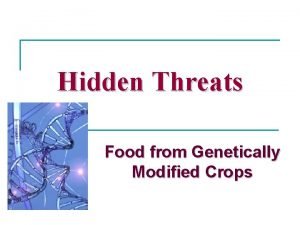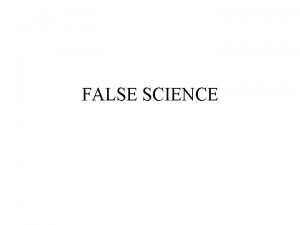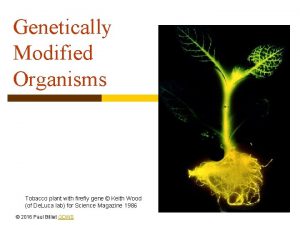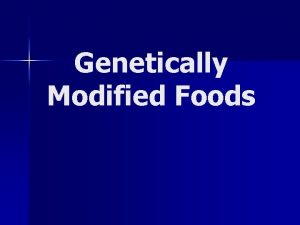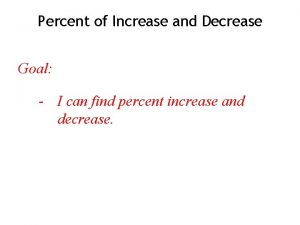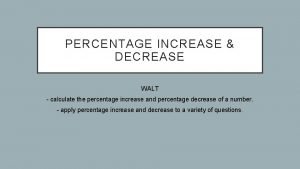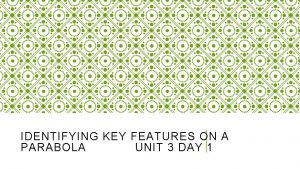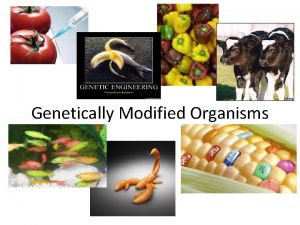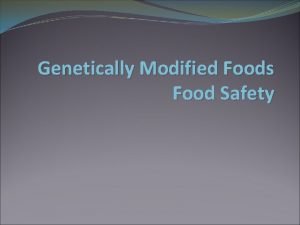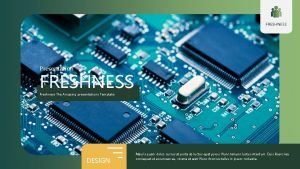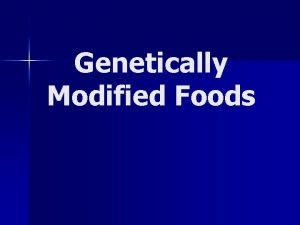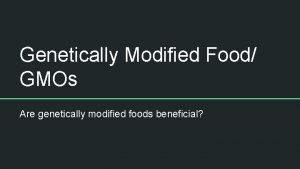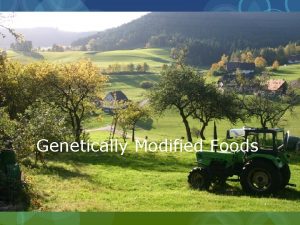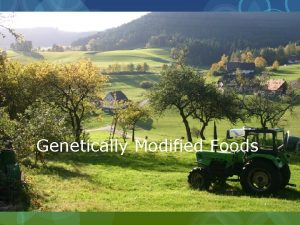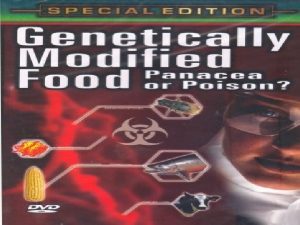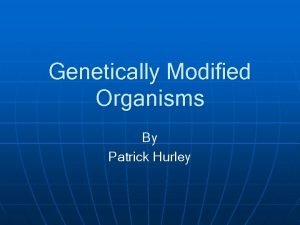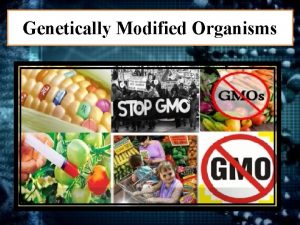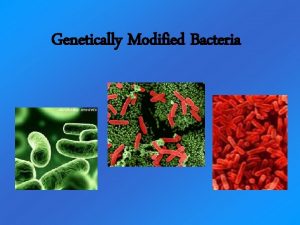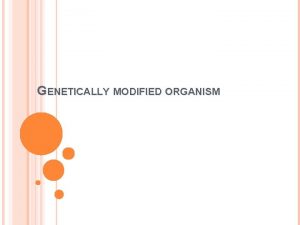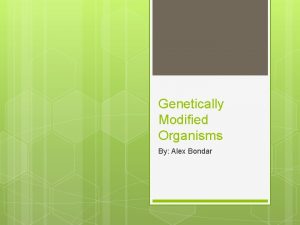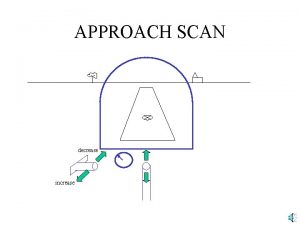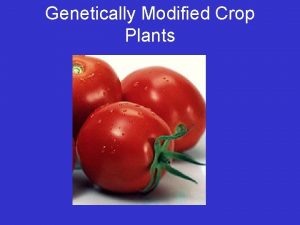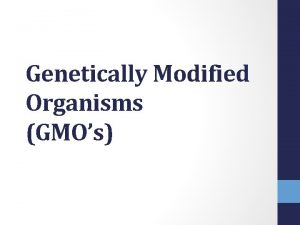Genetically Modified Foods WHY MODIFY Increase freshness decrease





















- Slides: 21

Genetically Modified Foods

WHY MODIFY? • • Increase freshness (decrease rate of decay) Increase vitamin content Pesticide resistance Increase crop yield Larger fruits/vegetables Shift growing season Etc….

WHAT IS GENETIC MODIFICATION? • An alteration of the plant’s genome – injection of hormones or antibtiotics is NOT an example of genetic modification • A foreign gene is inserted into the plant’s genome • Gene then codes for a specific protein (e. g. antibiotic resistance)

HOW ARE PLANTS MODIFIED? • Series of steps – Isolation of desired gene (mapping) – Gene cut from genome (restriction enzymes) – Gene amplified through PCR (polymerase chain reaction) – Target gene incorporated into plant (transformation) – Plant produces seeds with new gene

GENE MAPPING • Review – Recombination frequency = map units – Linkage map (relative location) – Cytological map

RESTRICTION ENZYMES • • • Molecular scissors Cut DNA in specific places (bp sequences) Leaves “sticky ends” which can be joined with DNA ligases

POLYMERASE CHAIN REACTION • PCR can be used to make copies of selected segments of available DNA • PCR needs – DNA molecule or fragment – Nucleotides - all four – DNA polymerase – Primers

PCR • Primer - an artificially made single-stranded sequence of DNA required for the initiation of replication • When all ingredients are combined and heated, DNA will double every 5 minutes

PCR

PCR • Heating the DNA separates the strands • DNA polymerase from a thermophilic bacterium is used because it is not adversely affected by the heating process • Drawback - sensitivity so samples can be easily contaminated

TRANSFORMATION • Genetic engineering of plants easier than animals – Natural transformation system for plants (bacterium Agrobacterium tumefaciens) – Plant tissue can redifferentiate (a transformed piece of leaf can regenerate to a whole plant) – plant transformation & regeneration are relatively easy for a variety of plants

BACTERIAL TRANSFORMATION • Soil bacterium A. tumefaciens can infect wounded tissue & transfer large plasmid (Ti plasmid) • Genes from Ti plasmid integrated into the plant chromosome are expressed at high levels

“SHOTGUNNING” • DNA can be delivered into the cells by small, µm-sized tungsten or gold bullets coated with the DNA • Device uses a sudden change in pressure of He gas to propel the particles • “Gene gun” or “shotgun” technique

ELECTROPORATION • A jolt of electricity is used to puncture selfrepairing holes in protoplasts (the cell without the cell wall), DNA can get in through holes • Often difficult to regenerate fertile plants from protoplasts of cereals • Significant advances in overcoming these practical difficulties have been made over the years

• Essentially all major crop plants can be (and have been or are being) genetically engineered • Procedures are now routine and the frequency of success is very high

PROBLEMS? • Expense – OK for Monsanto, but not for a local farmer or a poor county • Consumer perceptions – But haven’t humans always had a hand in manipulating our crops? • • Labeling Ethics

IDEAS FOR PRESENTATION • You can design your presentation to incorporate different issues • Issues for you to think about/address (include all, one, none, etc): – Economic impact – Environmental impact – Health concerns – include relevant research

MORE IDEAS… • Choose a “side” – Play the role of an organic farmer or an agricultural biotech firm and persuade your classmates! • Debate format (group of 3)

WEBSITES • http: //www. agresearch. co. nz/scied/search/bi otech/gene_gmomaking_plant. htm – How to genetically modify a plant • http: //www. food. gov. uk/gmfoods/ – Lots of information! • http: //scope. educ. washington. edu/gmfood/

WEBSITES • http: //www. biotechknowledge. monsanto. com / • http: //www 2. dupont. com/Biotechnology/en_ US/index. html – 2 large agricultural firms that currently use GE foods – Supply a LARGE % of American produce

MORE GREAT WEBSITES • http: //www. biotechknowledge. monsanto. com /biotech/bbasics. nsf/genetrans. html? Open. Page – Good overview of gene insertion • http: //ornl. gov/sci/techresources/Human_Ge nome/elsi/gmfood. shtml • http: //ohioline. osu. edu/hygfact/5000/5058. html
 Genetically modified organisms
Genetically modified organisms Genetically modified organisms
Genetically modified organisms Kayla antoniou
Kayla antoniou Mariam barseghyan
Mariam barseghyan Genetically modified crops have
Genetically modified crops have Rdna technology applications
Rdna technology applications Pleiotrophy
Pleiotrophy Genetically modified tobacco
Genetically modified tobacco Genetically modified food
Genetically modified food Quantity supplied vs supply
Quantity supplied vs supply Repeated percentage change
Repeated percentage change Percentage increase and decrease worksheet
Percentage increase and decrease worksheet Percent increase and decrease maze
Percent increase and decrease maze God increase and i decrease
God increase and i decrease What is repeated percentage change
What is repeated percentage change How to find the percent increase
How to find the percent increase Percentage increase and decrease questions and answers
Percentage increase and decrease questions and answers How to find percent increase
How to find percent increase Features of parabolas
Features of parabolas Coalition in a sentence
Coalition in a sentence Used so often as to lack freshness or originality
Used so often as to lack freshness or originality Used so often as to lack freshness or originality
Used so often as to lack freshness or originality




